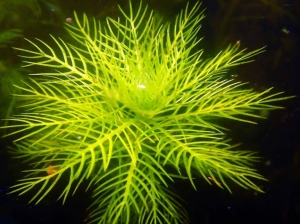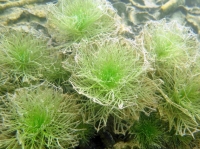Featherfoil - aquatic plant of the year 2021 in Germany, Austria & Switzerland
Science 01.12.2020
The species occurs particularly in small stagnant to slowly running waters and ponds, marshes and nutrient-rich mires. Quite rarely one finds it also in lakes - the featherfoil or water violet (Hottonia palustris). The German Underwater Federation (VDST) together with the Austrian Underwater Federation (TSVÖ), the Swiss Underwater Federation (SUSV) and CMAS have appraised the featherfoil as the "Water Plant of the Year 2021". We want to raise awareness to the threatened status of the species”, said and the urgent need for improved water protection and management.
The deeply devided leaves remind of those of the water milfoil (genus Myriophyllum). Its hermaphrodite flowers, which emerge up to 20-30 cm out of the water level in May and June, are particularly graceful. Only very few aquatic plants are pollinated by insects outside the water. The plant, actually belongs to the primrose family. In Europe, it is the only species of this family, which counts more than 600 species worldwide, that has a submerged lifestyle all year round.
The species is a true "moderate European", even if it occurs in the east as far as Western Siberia. It is rare in Northern Europe - it is missing in Norway. But also in the Mediterranean area the species is missing. So the feather foil is mostly distributed in the moderate-climatic parts of Europe between Ireland, Great Britain and France in the west and the Greater Vasyugan Mire in Russia in the east. In Germany it is not exclusively bound to lowlands, but more abundant there. It is on the early warning list and on the red lists of some German states, classified as "threatened" (RL3). On the red lists of Switzerland and Austria it is listed as "highly endangered" (RL2). Drainages, watercourse development accompanied by water pollution and eutrophication are the main causes of threat. In particular, agricultural nutrient and pesticide influx affect the feaetherfoil. The species actually appreciates a moderate to high nutrient supply, but hypereutrophication in intensively farmed regions and the greatly increased use of herbicides in agriculture are a major threat to it.
The featherfoil is one of those aquatic plants which, as so-called helophytes, copes well with fluctuations in water level. If water bodies fall dry, the featherfoil forms a landform, a 15mm high, dark green lawn. While the roots serve the water form only for adhesion purposes, the landform uses them for of their nutrition absortion. In the submerged form, the nutrients are absorbed through the leaf surfaces. The landform does not form flowers but can quickly adapt to submerged growth conditions again. Without doubt, the featherfoil is one of the most beautiful and peculiar European aquatic plants.
Photos by Silke Oldorff


























